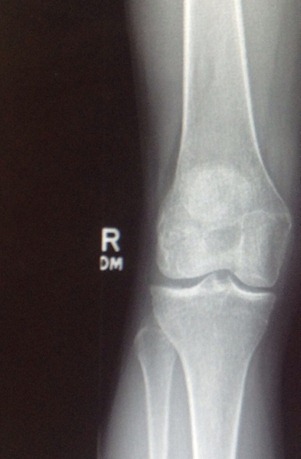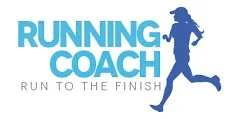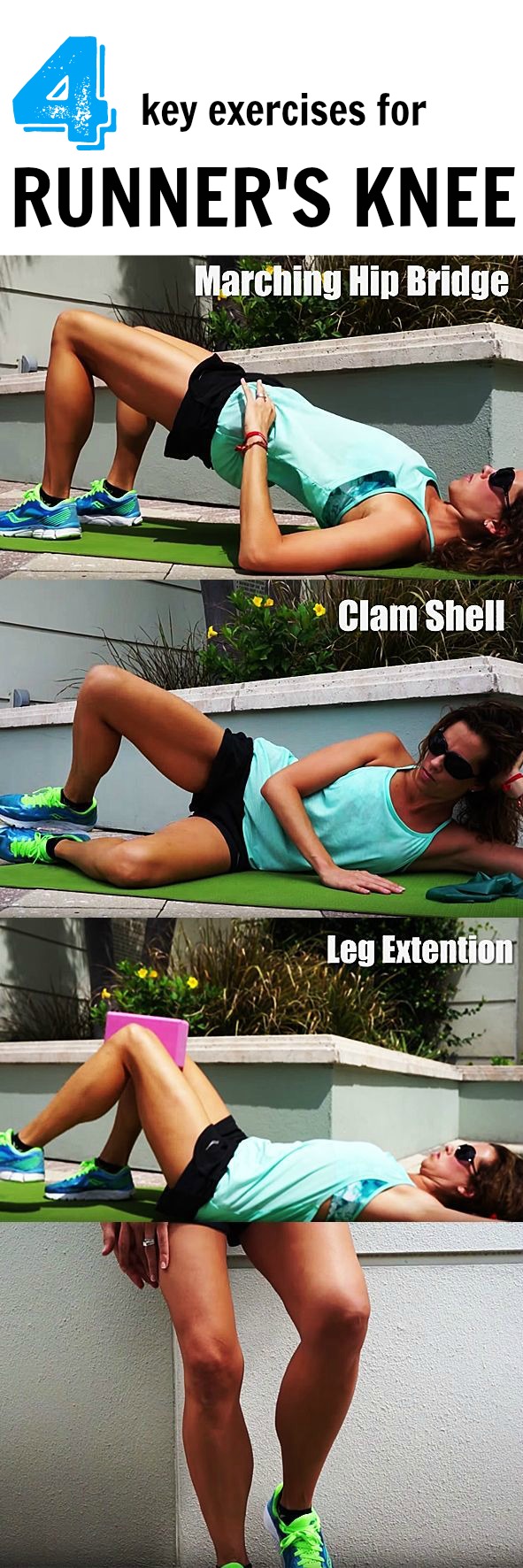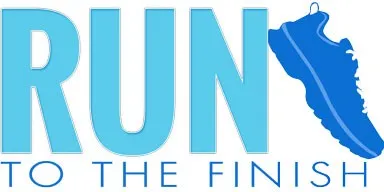Cycling is supposed to save your knees right??
People have been preaching that sermon to me since I started running: “you need to do something lower impact to save your knees”.
Ahh if I had a dollar. And yet, cycling knee pain has the same causes as runner’s knee.
My pain is your gain because I’ve now learned about runner’s knee from a whole new perspective.
When my hips started to hurt {from being out of alignment} I could bike without pain, so as any distance runner would, I climbed aboard and went for LONG rides.
Never once considering that a new workout might pinpoint some weakness in my body or cause other issues.
My knee swelling up like a cantaloupe happened after my victory ride, yup the one where I celebrated riding the longest ever {not hard to do when you are a new rider}.
I’m here to share with you all that I learned through experience and research, so you don’t have to go through what I did.
In this article, you’ll learn more about cycling knee pain including why it happens, how you can fix it if you’re currently experiencing it and how to prevent it entirely.
How to Prevent Cycling Knee Pain
Obviously, I’m not saying that running or biking will make everyone’s knees hurt. But there are more factors to consider if you’re going to start spending hours on the bike.
And after doing some specific physical therapy for runner’s knee, I was back to the bike to help improve my running.
It turns out, I just need to spend a little more time learning the right way to bike, including how to stay injury free, which may include things that running does not.
But the information I learned was so helpful in preventing knee pain all around, that I know other cyclists and runners will benefit from it.
A study published in 2010 in the American Journal of Sports Medicine found that 94 percent of professional cyclists experienced some sort of overuse injury over a year and 23 percent of those that did reported knee pain.

Since even professional cyclists suffer from injuries due to cycling, it’s important to understand the mechanics to make sure we don’t end up in the same boat.
As runners, we might not know as much about cycling and it can lead to injuries and issues down the line. So, if you’re cycling for cross training, go through this article for everything you need to know.
Before we proceed, please note that the scope of this article is limited to common overuse injuries from cycling.
If you’ve sustained an acute injury or experienced sudden pain, please seek appropriate qualified medical help immediately especially if your symptoms don’t improve with the advice in this article.
Cycling Knee Pain Chart
This chart of the major causes of knee pain is a great place to start figuring out what you need to work on.
Is it your hips, your glutes, your form, your mobility? After the chart, I’ll list some of the most common issues.
You can start to pin point what areas you may need to evaluate.

Causes of Runner’s Knee
In my case {and many others} biking caused a flare up of what is ironically runner’s knee. So yes, cycling is bad for runner’s knee, but also the wake up call you might need to do the exercises I list below CONSISTENTLY.
Patellofemoral pain syndrome (PFPS) is simply the knee tracking incorrectly and is often called runner’s knee because we tend to be the recipients of this due to weak muscles from only moving in a forward motion.
Hence it also afflicts cyclists who are also moving only in one direction for the majority of their workouts.
Runners may describe this pain as right below their knee cap, where cyclists may point to the inside or outside of their knee cap pain. This is due to the difference in motion and where the friction is being created.
Other symptoms include crackling or popping sounds in your knee when standing up or pain that increases when you’re running downhill or downstairs.
I’m going to really let you see deep inside me now…here’s my knee.
Where the femur has two bumps your knee should easily slide through when moving. Pain occurs when due to poor movement patterns we repeatedly push the knee to one side and over one of those bumps.
As you might imagine this creates inflammation in the tendons and wears the cartilage, thus creating what we refer to as runner’s knee.

How Cycling Can Cause Knee Pain
We often believe that because cycling in low impact it can’t possibly hurt our knees. But there’s a whole lot of potential for things to go wrong here as well.
Especially because as runners we turn to it when injured or for a change and don’t simply go for a short ride, we start doing long rides ASAP.
Here are the top ways cycling can cause knee pain. Later we’ll look at different areas we may experience cycling knee pain to understand each of these better.
Tight Hips/Glutes
As the leg goes near top stroke, the knee drifts to the side pulled by a tight hip
Tight IT Band/Weak Inner Thigh
A tight IT band will pull the knee out to the side as well and many runners have weak inner thighs from only forward movement, so they can’t counteract the pull.
Weak Glutes
The body will compensate with power from the quads, which again loads the knee. The number of times I’ve heard a PT tell someone weak glutes caused there pain…9 out of 10.
So start working on it!
Toe Pedaling (Running on Your Toes)
Places the knee in flexion throughout the stroke. While running on your toes will also lead to calf pain that can help you stop, it’s often harder to notice you’re doing it while biking.
Seat Position
Both too low or too forward will cause issues for the knee {proper bike fitting resolves}. Should be a 25° to 30° flexion in the knee when the pedal is at the bottom-most point
Overtraining
Much like running, overtraining while cycling can cause knee pain. Remember to gradually increase your cycling mileage to ensure you stay injury-free.
As always, slowly increase both distance and intensity to give you body time to adjust.
Tired of fighting knee pain? This is a must read runner's! via @runtothefinish Share on XAreas of the Knee Where You May Experience Cycling Knee Pain
Now that we’ve gone through an overview of how cycling can cause knee pain, it’s important to understand how it affects different areas of the knee and what to do about it.
The knee is a complicated joint, and if you experience pain within the knee it might not always be the knee itself that’s the problem.
Remember that the knee is basically a hinge between your hip and ankle and this can put a lot of pressure on the knee from other joints and muscles.
So many structures are involved when it comes to the knee that even if the pain is localized to the knee, you need to check out other parts of the body including the ankle, hip, and lower back.
There are four main parts of the knee where you might experience cycling knee pain. Let’s take a look at each of these:
1. Anterior Knee Pain – Pain at the Front of the Knee
One of the most common forms of cycling knee pains is pain at the front of the knee, also known as anterior knee pain.
This is usually caused by tightness in the quadriceps or the Iliotibial band (IT band), which is a thick ‘band’ of connective tissue (fascia) that runs along the outside thigh all the way from your hip and pulling on the patella (knee cap).
It can occur either because of the bike fit or because of tightness due to overuse.
Pain at the front of the knee can also come as a result of damage to the meniscus or cartilage, often due to trauma or repetitive moments.
If the knee is held in a wrong position over extended periods of time, it can really agitate the tendons where the quads attach at the front just below the knee cap. Pain in this manner can be severe and can spread around the knee.
How to Fix Anterior Knee Pain
Start by checking your bike fit as pain at the front of the knee often comes about from the saddle being too low and too far forward.
You might feel you get more power while cycling with this bike configuration, but it means you’re sitting on top of the knee and pushing a lot of force through it that can lead to this kind of pain.
Tightness can also be as a result of an improper bike fit or simply due to heavy mileage. This is where foam rolling and stretching become crucial. I’ve mentioned exercises at the end of this article that can help with this issue tremendously.
KT pain (kinesiology therapeutic tape) can also ease pain by pushing the patella into the correct position.
But while this will help with discomfort, it’s important to address the underlying issue; if you have tight muscles, you need to be able to relax them so that they naturally go into the right position.
2. Posterior Knee Pain – Pain at the Back of the Knee
While pain at the front of the knee (anterior) usually involves the quads, pain at the back of the knee, also known as posterior knee pain, is often due to the hamstrings.
When it comes to cycling and bike fits, there’s a general rule:
Pain at the front of the knee (anterior) = saddle is too low
Pain at the back of the knee (posterior) = saddle is too high
These are the easiest things to check first and foremost when you experience cycling knee pain.
Pain at the back of the knee can come from overextension which happens when the saddle is too high. The muscles tend to get very tight, and the knee inadvertently can’t cope with that degree of flexing.
Essentially, the hamstrings are being pulled and you’ll feel pain there where the muscle inserts around the knee at the back.
It’s a common misconception that we don’t really use the hamstrings while cycling, as we definitely do in the pull-up stroke. It tends to shorten the hamstring and make them tighter.
If too much pressure is placed on them, it can pull on the pelvis. To counteract this, your quads may try to step in which can then cause a hip movement that results in a leg length discrepancy. All of this can put a lot of pressure on the knee itself.
How to Fix Posterior Knee Pain
As with anterior knee pain, the first thing you need to do is check your bike fit for saddle height and saddle positioning to see if it is too high or too far back.
Again, foam rolling and stretching the posterior chain, i.e., the hamstrings, calves, and glutes, is essential to avoid this type of pain and to also resolve it. I’ve mentioned exercises at the end of this article that I’m sure you’ll find useful!
3. Medial (Inside) and Lateral (Outside) Knee Pain
The other two areas of the knee where you might experience cycling knee pain are the medial, or inside of the knee, and the lateral, or the outside of the knee.
Tight IT band and quads can be the cause of both these types of pain, but it may also be as a result of anterior and posterior knee pain that we discussed earlier.

When the IT band becomes tight or strained, it can cause a sharp pain on the exterior of the knee where the band joins the tibia.
Another major reason to experience both lateral and medial knee pain is cleat positioning. Cleats are the part of a clipless pedal that attaches to the bottom of cycling shoes.
In most instances, your cleats should be set up straight while cycling. If they’re tilted inwards, your knee will be forced to follow the ankles and track inwards, or vice versa. This can cause pain inside and outside the knee.
How to Fix Medial and Lateral Knee Pain
If you’re a runner that’s trying to get into triathlons, it may be a good idea to visit a professional bike fitter to find the optimum cleat position. Otherwise, all you need to do is aim for a neutral position.
Your cleats should be under the ball of the foot to avoid any issues that can arise from a misalignment.
Other Bike Fit Related Cause of Cycling Knee Pain
There are other factors in terms of bike fit that might lead to cycling knee pain.
- Saddle discomfort, or a saddle sore, is one of these factors. It can cause you to sit off-center, which can result in incorrect tracking as the pelvis shifts and act as if you have a leg length discrepancy.
- Low handlebars on your cycle can also result in pain, especially if the lower back becomes fatigued and it changes your natural movement pattern.
- Adjust different things to optimize for a good bike fit so that your bike works for you, and not against you.
Cycling Knee Pain as a Result of Weakness in the Glutes and Core
When it comes to cycling, the quads and calves are what comes to mind and what we believe we should strengthen. But we forget that the legs work from the core, i.e., the lower back, abs, glutes, and hip flexors are all involved in cycling movements.
By having a stronger core, smaller and less efficient muscles won’t have to work too hard, other it can result in pain and discomfort.
A common cause of knee pain, that’s often overlooked, is weakness in the glutes. This can make the hamstrings and quadriceps work more than they need to.
A good indication of this is when you’re experiencing knee collapse, i.e., your knees are tracking inwards towards the top tube. It means that your glute isn’t stabilizing the leg enough. When the knee tracks inwards, it can become sore which will then lead to knee pain.
Now that we know everything there is to cycling knee pain, let’s look at the exercises we can utilize to fix it.
Exercises to Fix Cycling Knee Pain
As always consult your Physical Therapist before doing anything here, I’m speaking from my experience and from working with other runners over the last 12+ years.
My first recommendation is the lunge matrix to strengthen the IT Band. Issues with the ITB often cause runner’s knee because the tightness and pulling shift our knee alignment and our running form.
I started doing this after my injury in 2007 and have only had the occasional very short flare up since then. {Click to see a video of the lunge matrix}
Second are a series of moves that focus on creating better hip stability, which in turn means your knee isn’t being pulled all over the place by weakness up the chain. {Click to see these hip stability moves.}
I know you have plenty to do without adding in tons of moves, but a few minutes before or after each run are worth the time you won’t spend injured.
Finally here are the newest exercises that I am adding to my routine of stretching, foam rolling and the above exercises to help get my glutes and inner thigh muscles firing appropriately.

Squeeze with raise
Using a small ball or yoga block, squeeze knees together and simultaneously extend one leg. Repeat 10 times per leg to work the quad right near your knee. You have to stay focused on the squeeze.
Clam shell with resistance
Admittedly I was doing this prior to the injury, but without the band…that adds a whole new level.
Laying on your side with knees together, focus on contracting your deep core muscles then with feet touching raise your top leg. This is going to work core and your outer hip. Repeat 10 times per leg.
Bridge March
The key to this exercise is not to let your hips sway at all while doing the movement. It requires focusing on your core, your glutes and well everything to keep it stable. The march is slow and only done for up to 1 minute. As soon as you start to see hip movement stop.
NOTE: I tried to keep this as non-medical as possible to get straight to the details, so please no pointing out that is the Vastus Medialis Oblique Muscle and not inner thigh, I get it, but wanted this to be helpful to everyone.
Hopefully this video of exercises for cycling knee pain will demonstrate what was described above.
Are you consistent with PT type exercises?
Ever find a new workout highlights poor movements you’ve just gotten used to?
Other ways to connect with Amanda
Instagram Daily Fun: RunToTheFinish
Facebook Community Chatter: RunToTheFinish
Sign Up to Receive a Weekly Newsletter with Top Running Tips and Laughs
Checkout the Ultimate IT Band Solution >>
Here’s a pinnable image of the moves in the video, so you can remember them later as well.



 3 Full Body Workouts For Runners
3 Full Body Workouts For Runners
I’d really like to thank you for this article. I had been reading a lot of articles about this topic and none of them explained so clearly and with an xray image of what is going on in there (knee). I have been suffering from the same since late Nov 2016 . I thought 2 months later it would be gone but its still there. The knee allows me to bike and run but as long as I dont go hard. Thanks for the tips to strenghten the weaknesses.
Great article thank you
I’m mid 50’s female just getting back into cycling and really enjoying it, and noticing any little ache ! And aware my left knee has ached slightly during a ride. Thanks for the stretches.
I will be monitoring by riding position.
Allison
I followed these exercises and it helped me a lot to cure my knee pain problem. I also recommend everyone who is suffering from knee pain to try these exercises.
Thanks for sharing.